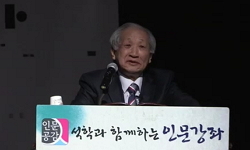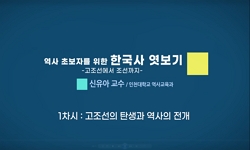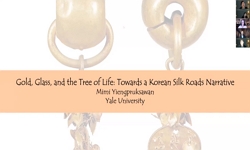초기 서사물 가운데서도 『古記』는 특히 聖顯의 구축에 남다른 모습을 보여주는 사례라 할 것이다. 그에 수록된 예화들은 대체로 불경과 신화의 특성을 구비하고 있어 종교서사, 신화에서 ...
http://chineseinput.net/에서 pinyin(병음)방식으로 중국어를 변환할 수 있습니다.
변환된 중국어를 복사하여 사용하시면 됩니다.
- 中文 을 입력하시려면 zhongwen을 입력하시고 space를누르시면됩니다.
- 北京 을 입력하시려면 beijing을 입력하시고 space를 누르시면 됩니다.
https://www.riss.kr/link?id=A101735682
-
저자
김승호 (동국대학교)
- 발행기관
- 학술지명
- 권호사항
-
발행연도
2015
-
작성언어
Korean
-
주제어
성스러움의 표출 ; 신성한 공간 ; 신성한 시간 ; 불교적 신성관 ; 신라 ; Li<Gogi> ; manifestation of sacredness ; holy space ; holy time ; Buddhistic view of god ; Cheonchuk ; Silla ; 古記 ; 天竺
-
KDC
810
-
등재정보
KCI등재
-
자료형태
학술저널
-
수록면
351-377(27쪽)
-
KCI 피인용횟수
1
- DOI식별코드
- 제공처
-
0
상세조회 -
0
다운로드
부가정보
국문 초록 (Abstract)
초기 서사물 가운데서도 『古記』는 특히 聖顯의 구축에 남다른 모습을 보여주는 사례라 할 것이다. 그에 수록된 예화들은 대체로 불경과 신화의 특성을 구비하고 있어 종교서사, 신화에서 발견되는 담론적 특성을 확인해볼 수 있는 것이다. 이 점에서 『고기』의 聖顯 구축 양상을 공간과 시간의 측면에서 구체화하는 것이 본고의 지향점이다. 『고기』에서는 하늘 숭배의 상징적 대상으로 桓因을 지목하며 거듭 그를 등장시키고 있다. 이는 전래의 天觀念에 변화가 일고 있다는 사실과 함께 神聖性을 확보하는데 있어 桓因이 그만큼 적절한 신격으로 수용했음을 말해준다. 공간적 측면에서 『古記』는 天竺과 신라의 관계성 위에서 서사를 구성한다. 즉 天竺은 불교적 神聖性이 이미 확보된 이상적 공간으로 형상화된 반면 신라는 불법이 아직 전해지지 않은 무명에 덮인 곳으로 인식된다. 하지만 불보살의 도움에 의해 天竺의 神聖性이 신라로 이식되는 단계를 맞게 되고 결국 天竺과 더불어 성스러움을 공유하는 공간으로 탈바꿈한다. 시간을 중심으로 『古記』의 聖顯양상을 보면 세속시간을 가능한 벗어나 원초적이고 신화적인 시간 위에서 서사를 진행한다는 특징을 보인다. 중국보다 앞서 불교를 수용했음을 표방하는 것은 물론 이 땅의 곳곳을 前佛時代의 절터, 불보살의 강림처로 확증하는 데 거리낌이 없다. 역사시간을 벗어나 신화시간으로 신라불교사를 편입시키는 것이야말로 성스러움을 증폭시키는 데 유효하다는 인식이 작용한 결과이다. 『古記』는 원시불교 시대 혹은 신화시대의 산물과 무관하지만 불교적 神聖性을 이야기 속에 끊임없이 주입하려했던 서사물로 규정할 수 있다. 『三國遺事』를 신이서사의 출발지점으로 인정하고 있는 터이지만 기실 『고기』가 聖顯的 역사 구축의 앞선 사례라 할 것이다.
다국어 초록 (Multilingual Abstract)
Religious narrative tends to be aimed at promoting piety, based on the ritual of worship toward gods. People hold ritual for god or the divine and revive the holiness of their existence through the sacred stories. Few materials concentrate on the cons...
Religious narrative tends to be aimed at promoting piety, based on the ritual of worship toward gods. People hold ritual for god or the divine and revive the holiness of their existence through the sacred stories. Few materials concentrate on the construction of saints as <古記> among early narratives. mythological discourse. Although it is not certain which of them, Buddhist scriptures or mythologies, influenced it more, the illustrations included in it confirm that it pursues sacred narratives as much as religious narratives or mythological discourse. This article aims to embody the building of saints from the perspective of space and time. From the spatial perspective, <Gogi> makes up the narrative based on the relation between Cheonchuk and Silla. That is to say, while Cheonchuk was embodied as ideal space which established Buddhist sacredness, Silla was perceived as the place covered with ignorance, where Buddhist teachings were not transmitted. However, thanks to the help of Buddha and Bosatsu, the sacredness of Cheonchuk was transplanted to Silla, and in turn transformed into a space sharing deity with Cheonchuk. The sacred spectrum of <Gogi> displays the feature of running narratives on the primitive and mythological time out of the worldly time. It is unrestrained in manifesting the acceptance of Buddhism prior to China and confirming every corner of this land as the temple site and advent place of Buddha and Bosatsu. This results from the perception that the inclusion of Silla Buddhist history as mythological time is effective to enlargement of sacredness. It was revealed that <Gogi> was historical legendry which tried to inject incessantly Buddhistic sacredness in the narratives. 'Sin-i sagwan' in <Samgukyusa> in later times appeared actually in <Gogi>, and therefore it is considered related to the succession of the previous tradition of constructing sacred Buddhistic history.
목차 (Table of Contents)
- 국문초록
- 1. 문제제기
- 2. 불교의 天神과 桓因의 개입
- 3. 천축과 신라의 等位的 병치
- 4. 탈역사와 始原의 소급
- 국문초록
- 1. 문제제기
- 2. 불교의 天神과 桓因의 개입
- 3. 천축과 신라의 等位的 병치
- 4. 탈역사와 始原의 소급
- 5. 맺음말
- 참고문헌
- Abstract
참고문헌 (Reference)
1 閔漬, "金剛山楡岾寺事蹟記"
2 동국대 역경원, "한글대장경" 1110-1111, 1995
3 동국대 역경원, "한글대장경" 999-, 1995
4 김화경, "한국 구비설화의 연구" 영남대출판부 5-7, 1987
5 동국대불교문화원 HK연구단, "테마 한국불교1" 동국대출판부 127-, 2013
6 윌리엄 페이든, "종교의 세계" 청년사 108-, 2004
7 토마스 F 오데아, "종교사회학" 이대출판부 44-48, 1996
8 최남선, "육당 최남선전집, 2권" 현암사 191-, 1981
9 미르치아 엘리아데, "영원회귀의 신화" 이학사 48-, 2009
10 라스무센, "상징과 해석" 서광사 108-, 2000
1 閔漬, "金剛山楡岾寺事蹟記"
2 동국대 역경원, "한글대장경" 1110-1111, 1995
3 동국대 역경원, "한글대장경" 999-, 1995
4 김화경, "한국 구비설화의 연구" 영남대출판부 5-7, 1987
5 동국대불교문화원 HK연구단, "테마 한국불교1" 동국대출판부 127-, 2013
6 윌리엄 페이든, "종교의 세계" 청년사 108-, 2004
7 토마스 F 오데아, "종교사회학" 이대출판부 44-48, 1996
8 최남선, "육당 최남선전집, 2권" 현암사 191-, 1981
9 미르치아 엘리아데, "영원회귀의 신화" 이학사 48-, 2009
10 라스무센, "상징과 해석" 서광사 108-, 2000
11 하정룡, "삼국유사의 사료비판" 민족사 207-, 2005
12 베르나르 포르, "동양종교의 죽음" 영림카디널 124-, 1997
13 徐兢, "高麗圖經, 卷17, 寺宇 정국안화사조"
14 中觀海眼, "頭輪山大屯寺事蹟"
15 김승호, "聖談 혹은 怪談, 그 인식적 간극 - 古記소재 神話에 대한 지식인의 반응을 중심으로" 어문연구학회 81 : 47-70, 2014
16 閔黯, "美黃寺事蹟碑" 1004-1005, 1692
17 松潭性鍒, "湖南金溝縣東母岳山金山寺大法堂重修記"
18 "梵宇攷, 海南寺刹條"
19 桂陰浩然, "曺溪山仙岩寺事蹟"
20 "新羅含月山祇林寺事蹟"
21 "支提志"
22 "慶州含月山祇林事蹟"
23 休靜, "妙香山法王臺金仙臺記"
24 김승호, "古記와 三國遺事에 나타나는 史話的 동질성과의미" 불교문화연구원 (67) : 161-183, 2014
25 김승호, "古記 소재 불교설화의 성격과 의미" 한국고전문학회 (44) : 129-155, 2013
26 一然, "三國遺事"
27 김영경, "三國史記와 三國遺事에 보이는 古記에 대하여" 25-, 1984
28 김상현, "『古記』의 사학사적 검토" 한국고대사학회 (74) : 285-324, 2014
동일학술지(권/호) 다른 논문
-
- 열상고전연구회
- 유춘동
- 2015
- KCI등재
-
- 열상고전연구회
- 열상고전연구회
- 2015
- KCI등재
-
- 열상고전연구회
- 김기덕
- 2015
- KCI등재
-
전주시 역사문화자원의 활용과 도시재생 - 전주 한옥마을을 중심으로 -
- 열상고전연구회
- 홍성덕
- 2015
- KCI등재
분석정보
인용정보 인용지수 설명보기
학술지 이력
| 연월일 | 이력구분 | 이력상세 | 등재구분 |
|---|---|---|---|
| 2028 | 평가예정 | 재인증평가 신청대상 (재인증) | |
| 2022-01-01 | 평가 | 등재학술지 유지 (재인증) |  |
| 2019-01-01 | 평가 | 등재학술지 유지 (계속평가) |  |
| 2016-01-01 | 평가 | 등재학술지 유지 (계속평가) |  |
| 2012-01-01 | 평가 | 등재 1차 FAIL (등재유지) |  |
| 2009-01-01 | 평가 | 등재학술지 선정 (등재후보2차) |  |
| 2008-01-01 | 평가 | 등재후보 1차 PASS (등재후보1차) |  |
| 2006-01-01 | 평가 | 등재후보학술지 선정 (신규평가) |  |
학술지 인용정보
| 기준연도 | WOS-KCI 통합IF(2년) | KCIF(2년) | KCIF(3년) |
|---|---|---|---|
| 2016 | 0.54 | 0.54 | 0.56 |
| KCIF(4년) | KCIF(5년) | 중심성지수(3년) | 즉시성지수 |
| 0.59 | 0.58 | 0.973 | 0.16 |




 KCI
KCI eArticle
eArticle






